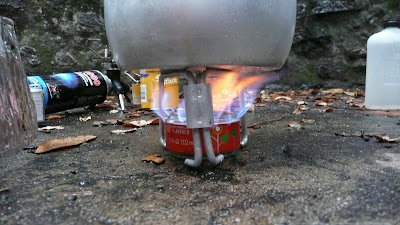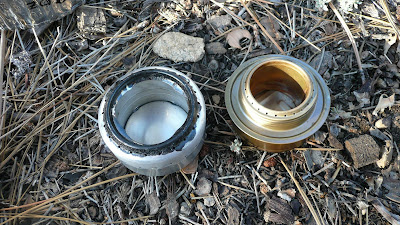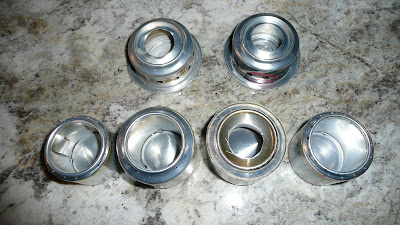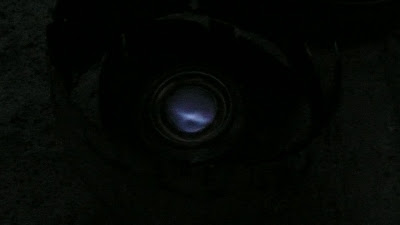Great Article by http://adventuresinstoving.blogspot.com DIY Alcohol Stoves -- Basic Design Considerations: In a pinch, you can use just about anything to make an alcohol "stove" out of. Really, there are only two criteria: Your stove has to be able to hold a liquid, and your stove can't be made of a flammable material.
What's that? Oh, you want a good stove? Yeah, well that's just a bit more complicated, but no worries. Let's talk about a few basics of alcohol stove design.

Various alcohol stoves prior to testing
OK, so what constitutes a good stove? Everyone is going to look at this a little differently, but here's my critiera:
What's that? Oh, you want a good stove? Yeah, well that's just a bit more complicated, but no worries. Let's talk about a few basics of alcohol stove design.
Various alcohol stoves prior to testing
OK, so what constitutes a good stove? Everyone is going to look at this a little differently, but here's my critiera:
1. Lightweight. Hey, I gotta carry this thing, right? And if I'm going to give up the convenience of gas, then I better be getting something out of it -- like a lighter pack.
2. Efficient. So, what good is a light stove if it eats fuel like an old 450 V8 Chevrolet engine with a four barrel carburetor? Who cares if the stove is light if I have to carry four times the fuel?! The danged thing needs to save me weight, remember? I want a stove that will do the job with a minimum amount of fuel.
3. Effective. Lightweight? Yeah. Efficient? Yeah. But it has to do the job. A stove that won't cook doesn't save me anything. It's got to work. Not negotiable.
4. Minimum "fiddle factor." If I need a degree in mechanical engineering and a Rube Goldberg mindset just to run the thing, then it's not the stove for me.
2. Efficient. So, what good is a light stove if it eats fuel like an old 450 V8 Chevrolet engine with a four barrel carburetor? Who cares if the stove is light if I have to carry four times the fuel?! The danged thing needs to save me weight, remember? I want a stove that will do the job with a minimum amount of fuel.
3. Effective. Lightweight? Yeah. Efficient? Yeah. But it has to do the job. A stove that won't cook doesn't save me anything. It's got to work. Not negotiable.
4. Minimum "fiddle factor." If I need a degree in mechanical engineering and a Rube Goldberg mindset just to run the thing, then it's not the stove for me.
With me so far? Sure, we can think of more criteria, but those are the basics. Let's go with those and see what we can come up with.

Preparing to test another set of alcohol stoves
You can make an alcohol stove out of most anything, but aluminum drink cans are the most commonly used item for DIY alcohol stoves. They're light, they're easy to get, and there's a free drink inside if you buy the can! :)
Now here's where it gets tricky. There are 10,000 ways to slice and dice an aluminum can to make a stove. There are tons of sites out there on the net that list detailed templates. I may post something like that at some point, but that's not my purpose today. What I'd like to do is take a step back and look at a slightly bigger picture in terms of DIY alcohol stove design: What are some of the basic considerations involved? In other words, in terms of design, what works?
For the purpose of this post, I'm going to limit the discussion to open type alcohol burners. There are many, many types of alcohol burners, but just to keep this post shorter than War and Peace, I'm going to limit the discussion to open type burners. Open burners are relatively easy to make, effective, and widely used, so it's not like we're limiting ourselves too much.

Testing various open type burners
OK, so any fool can lop the top off an aluminum can, splash in some alcohol, and light it on fire. The chances of getting an efficient stove that way are pretty much zero. For example, take a look at this photo:

An alcohol stove made from 23.5 fluid ounce/695ml drink cans
See those towering, bright yellow flames? This stove puts out a lot of heat, but it burns through a lot of alcohol quickly. Can you say "inefficient?" The first lesson of alcohol stove design is this: fast stoves are fuel hogs. The corollary to that is that slow stoves are more efficient.
So, what's the problem with the above stove? Poor materials? Poor execution? Not really. It's a design issue. It just burns too darned fast. So how can we slow it down and make it more efficient?
It's hard to tell in the photo above, but that's a bigger than average stove. It's made out of 23.5fl oz/695 ml sized cans. What if we downsized a little bit? Take a look at this stove. It's made out of 7.5fl oz/222ml sized cans.

An alcohol stove made from 7.5 fluid ounce/222ml drink cans
Much better! Much smaller flames and a lot less yellow. So, lesson two: The width of the burner matters.
So is that the answer? Just use a small can? Take a look at this photo:

Various types of alcohol stoves being tested.
Notice that there are three stoves made from the smaller cans. The two shorter small stoves have bright yellow flames (inefficient), but notice that the taller one in the center of the back row. Its flames are a nice pale blue -- you can barely see them. So, lesson three is that the height of the burner is important.
Now, did you notice the brass burner in the photo above? That's no DIY burner, that's a Trangia burner. Trangia has been making alcohol burners since at least 1951, and they're pretty darned good burners. Can we learn anything by looking at a Trangia burner? Let's compare it to the stove we called inefficient in the first photo above.

An alcohol stove made from 23.5fl oz/695 ml drink cans (left) and a Trangia burner (right)
Well, now what the heck? The two stoves have roughly the same width at the base, but the Trangia is pretty efficient, and the other stove, well, it isn't. What's the difference? Take a look at the opening in the Trangia burner. Notice that it's not full width. The opening is smaller than that the width of the entire burner. Lesson four: Yes, width matters, but the width of the opening is more important than the width of the entire burner.
OK, now take a look at this photo:

Alcohol stoves of varying designs.
The two stoves in the back row are the proven 12-10 stove from Trail Designs. Note how the opening is smaller than the width of the cans -- just like the Trangia. Hey, maybe we really are on to something here!
Now, take a look at the third stove from the left in the front row. Note how it too has an opening smaller than its width. It's a little hard to tell from that photo, but that's a very tall stove. Recall from lesson three that the height of the burner is important. So, let's fire that burner up and see how it works.

Testing a tall stove with a small opening.
Well, we've certainly gotten rid of those nasty yellow flames! But this thing is a PITA to get started, and the flame is so small that it barely heats water. It might be fine for simmering, but it won't boil water. After 20 minutes, my water still hadn't boiled, so I cancelled the test. This model just isn't practical.
Height makes for a more efficient stove, but too tall and your water never boils. There is a relationship between height and opening size, so lesson five: For a practical stove, the relationship between height and opening size is approximately 1:1.
What would a stove with a 1:1 opening size to height look like? About like this:

An alcohol stove where the opening size is approximately equal to the height of the stove
So, great theory, but does it work in practice? As a matter of fact that ratio works pretty well.

A 1:1 ratio alcohol stove in use
Yeah, there's a little yellow in the flame, but that's not bad when you compare the size and amount of yellow to the stove in the first photo in this post. And the flame is a nice middle of the road size. It's not so small as to be useless, yet it's not so large as to be wasteful. In my tests with 500ml of approximately 45F/7C water, I was able to bring the water to a boil with about 1/2 fluid ounce (approx. 15ml) of green denatured alcohol. In terms of efficiency, that's pretty good.
So review:
1. Fast stoves are fuel hogs; slow stoves are more efficient.
2. The width of the burner matters
3. The height of the burner matters
4. The width of the opening is actually more important that the width of the burner
5. For a practical stove, the relationship between the width of the opening and the height of the burner is about 1:1.
OK, there you have it, some basic design considerations for making a practical, efficient open type alcohol burner. There's more to it, such as exactly which template you want to follow, but in the interests of keeping this post shorter than the Encyclopedia Britannica or the New York City phone directory, I'm going to end things here for today.
HJ
Acknowledgments: I am indebted to many people who shared with me ideas about alcohol stove design. I'm sure I'll forget someone important, but when a debt of thanks is owed, better to remember to thank a few than to thank no one at all. My thanks to: James M, James N, Jon F, Kevin B, Turkoker, Tony B, and Zelph. Particular thanks to Will L. who patiently did the majority of the actual fabrication of the stoves (hey, I'm a blogger not a stove manufacturer. I'm really more of an "ideas" guy, see?). :)

Preparing to test another set of alcohol stoves
You can make an alcohol stove out of most anything, but aluminum drink cans are the most commonly used item for DIY alcohol stoves. They're light, they're easy to get, and there's a free drink inside if you buy the can! :)
Now here's where it gets tricky. There are 10,000 ways to slice and dice an aluminum can to make a stove. There are tons of sites out there on the net that list detailed templates. I may post something like that at some point, but that's not my purpose today. What I'd like to do is take a step back and look at a slightly bigger picture in terms of DIY alcohol stove design: What are some of the basic considerations involved? In other words, in terms of design, what works?
For the purpose of this post, I'm going to limit the discussion to open type alcohol burners. There are many, many types of alcohol burners, but just to keep this post shorter than War and Peace, I'm going to limit the discussion to open type burners. Open burners are relatively easy to make, effective, and widely used, so it's not like we're limiting ourselves too much.
Testing various open type burners
OK, so any fool can lop the top off an aluminum can, splash in some alcohol, and light it on fire. The chances of getting an efficient stove that way are pretty much zero. For example, take a look at this photo:
An alcohol stove made from 23.5 fluid ounce/695ml drink cans
See those towering, bright yellow flames? This stove puts out a lot of heat, but it burns through a lot of alcohol quickly. Can you say "inefficient?" The first lesson of alcohol stove design is this: fast stoves are fuel hogs. The corollary to that is that slow stoves are more efficient.
So, what's the problem with the above stove? Poor materials? Poor execution? Not really. It's a design issue. It just burns too darned fast. So how can we slow it down and make it more efficient?
It's hard to tell in the photo above, but that's a bigger than average stove. It's made out of 23.5fl oz/695 ml sized cans. What if we downsized a little bit? Take a look at this stove. It's made out of 7.5fl oz/222ml sized cans.
An alcohol stove made from 7.5 fluid ounce/222ml drink cans
Much better! Much smaller flames and a lot less yellow. So, lesson two: The width of the burner matters.
So is that the answer? Just use a small can? Take a look at this photo:
Various types of alcohol stoves being tested.
Notice that there are three stoves made from the smaller cans. The two shorter small stoves have bright yellow flames (inefficient), but notice that the taller one in the center of the back row. Its flames are a nice pale blue -- you can barely see them. So, lesson three is that the height of the burner is important.
Now, did you notice the brass burner in the photo above? That's no DIY burner, that's a Trangia burner. Trangia has been making alcohol burners since at least 1951, and they're pretty darned good burners. Can we learn anything by looking at a Trangia burner? Let's compare it to the stove we called inefficient in the first photo above.
An alcohol stove made from 23.5fl oz/695 ml drink cans (left) and a Trangia burner (right)
Well, now what the heck? The two stoves have roughly the same width at the base, but the Trangia is pretty efficient, and the other stove, well, it isn't. What's the difference? Take a look at the opening in the Trangia burner. Notice that it's not full width. The opening is smaller than that the width of the entire burner. Lesson four: Yes, width matters, but the width of the opening is more important than the width of the entire burner.
OK, now take a look at this photo:
Alcohol stoves of varying designs.
The two stoves in the back row are the proven 12-10 stove from Trail Designs. Note how the opening is smaller than the width of the cans -- just like the Trangia. Hey, maybe we really are on to something here!
Now, take a look at the third stove from the left in the front row. Note how it too has an opening smaller than its width. It's a little hard to tell from that photo, but that's a very tall stove. Recall from lesson three that the height of the burner is important. So, let's fire that burner up and see how it works.
Testing a tall stove with a small opening.
Well, we've certainly gotten rid of those nasty yellow flames! But this thing is a PITA to get started, and the flame is so small that it barely heats water. It might be fine for simmering, but it won't boil water. After 20 minutes, my water still hadn't boiled, so I cancelled the test. This model just isn't practical.
Height makes for a more efficient stove, but too tall and your water never boils. There is a relationship between height and opening size, so lesson five: For a practical stove, the relationship between height and opening size is approximately 1:1.
What would a stove with a 1:1 opening size to height look like? About like this:
An alcohol stove where the opening size is approximately equal to the height of the stove
So, great theory, but does it work in practice? As a matter of fact that ratio works pretty well.
A 1:1 ratio alcohol stove in use
Yeah, there's a little yellow in the flame, but that's not bad when you compare the size and amount of yellow to the stove in the first photo in this post. And the flame is a nice middle of the road size. It's not so small as to be useless, yet it's not so large as to be wasteful. In my tests with 500ml of approximately 45F/7C water, I was able to bring the water to a boil with about 1/2 fluid ounce (approx. 15ml) of green denatured alcohol. In terms of efficiency, that's pretty good.
So review:
1. Fast stoves are fuel hogs; slow stoves are more efficient.
2. The width of the burner matters
3. The height of the burner matters
4. The width of the opening is actually more important that the width of the burner
5. For a practical stove, the relationship between the width of the opening and the height of the burner is about 1:1.
OK, there you have it, some basic design considerations for making a practical, efficient open type alcohol burner. There's more to it, such as exactly which template you want to follow, but in the interests of keeping this post shorter than the Encyclopedia Britannica or the New York City phone directory, I'm going to end things here for today.
HJ
Acknowledgments: I am indebted to many people who shared with me ideas about alcohol stove design. I'm sure I'll forget someone important, but when a debt of thanks is owed, better to remember to thank a few than to thank no one at all. My thanks to: James M, James N, Jon F, Kevin B, Turkoker, Tony B, and Zelph. Particular thanks to Will L. who patiently did the majority of the actual fabrication of the stoves (hey, I'm a blogger not a stove manufacturer. I'm really more of an "ideas" guy, see?). :)
Comentários
Postar um comentário